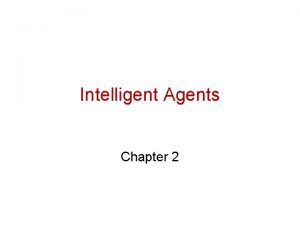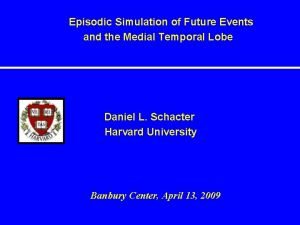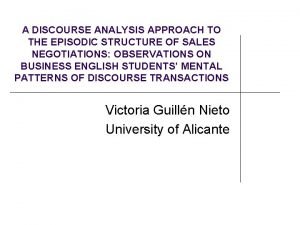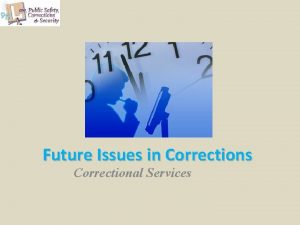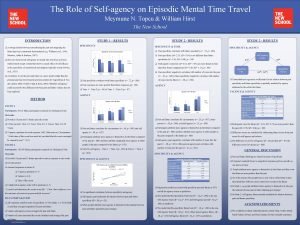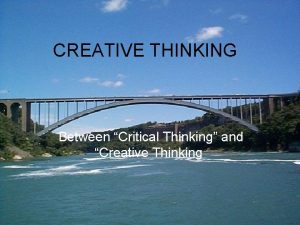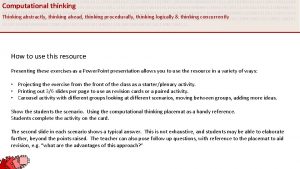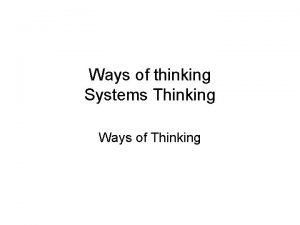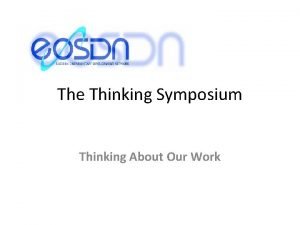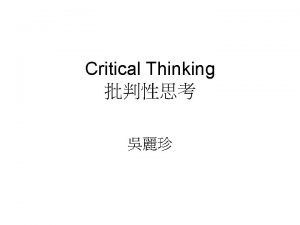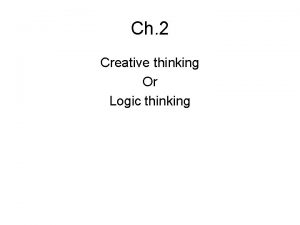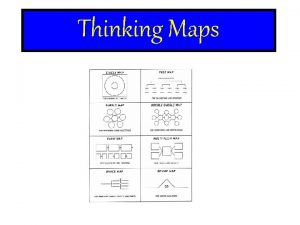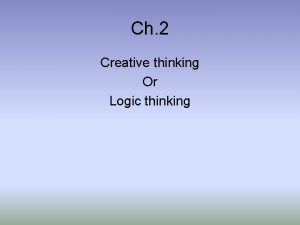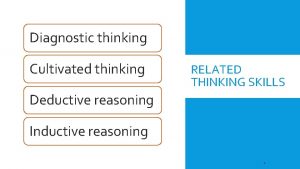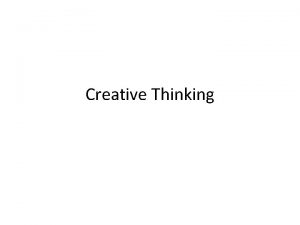Episodic Future Thinking The role of current and



























- Slides: 27

Episodic Future Thinking: The role of current and future concerns Scott Cole & Dorthe Berntsen ICPS, March, 2015; Symposium, Functions Of Future Thoughts

Johannessen & Berntsen (2010) • Assessed Involuntary (spontaneously arising) and Voluntary (strategically retrieved) memories in daily life (diary study method, see Berntsen & Hall, 2004) • Asked participants for five most important personal ongoing goals, current concerns

Current Concerns (Klinger, 1975) • Commitment to completion/disengagement • Have wide ranging effect upon perception, cognition and behaviour. • Individuals one time. have many current concerns at any

Johannessen & Berntsen (2010) • 50% involuntary and voluntary memories were related to at least one current concern Autobiographical Characteristics • Current Concern-related memories were more rehearsed, important to self identity and life story. • Item: “I often think about the effects this event will have on my future”. Rated higher for current concern-related events

• Future thoughts can represent future goal attainment and disengagement. • Aim 1: Will future thoughts be more related to current concerns than memories?

Future Thoughts and Goals • Future thoughts might underlie or influence important goal-oriented human functions, such as; • planning, • decision making • goal attainment • Klein, (2013); Schacter, (2012); Seligman, Railton, Baumeister & Sripada, (2013); Suddendorf & Corballis, (2007); Szpunar & Jing, (2013). • They may therefore garner beneficial outcomes for one’s future. E. g. , in preparing for a talk

Future Thoughts and Goals • Metacognitive Perceptions: Individuals perceive a role for their future thoughts in planning and goal attainment (D’Argembeau, Renaud & Van der Linden, 2011; Rasmussen & Berntsen, 2013) • Experimental Evidence: Episodic future thoughts are elicited more fluently when cued by personal goals (D’Argembeau & Mathy, 2011, Study 3) • Aim 2: Will voluntary future thoughts related to one or more current concerns be enhanced in terms of cognitive, representational and emotionally aspects?

CUE: Tree Branch Future Thought: Image of branch falling in front of me

CUE: Name of Professor Future Thought: Presenting work at ICPS Current Concern: Present work to a wide audience

Involuntary Mental Time Travel • Berntsen & Jacobsen (2008) and Finnbogadottir & Berntsen (2011). Involuntary future MTT as frequent as Involuntary memories (Finnbogadottir & Berntsen, 2013, around 20 per day) • Diary studies have not investigate goal-relatedness of involuntary future thoughts

Schlagman & Kvavalishvili (2008)

Cole, Staugaard & Berntsen (under review) ‘SECONDARY TASK’ Involuntary: 600 trials 1. 5 BUTTON PRESS B: “When I have a puncture while I am on my way home ” – triggered by “BICYCLE TYRE” PAUSES TASK s ‘PRIMARY TASK’ CR = BUTTON PRESS A (random occurrence, every 40 -60 trials)

Cole, Staugaard & Berntsen (under review) ONLY TASK Voluntary: 12 trials i m 1 n BUTTON PRESS A: “Have to break a promise because of an exam” – constructed using “BROKEN PROMISE” PAUSES TASK

Procedure (Past OR Future) Verbal instruction Randomly assigned: Past (N=28) OR Future (N=27) ‘Concentration’ Task (20 -30 mins) Trials (n = 600) Voluntary word task (12 -15 mins approx. ) Trials (N=12) Retrospective ratings, detailed description Current Concerns CFC 5 min break • Sequential order: To keep involuntary ‘clean’ of voluntary processes • Maximum Frequency: 12 involuntary and 12 voluntary events • CFC Individual difference measure: No relationship • First examination of IF in lab paradigm (Cole, Staugaard & Berntsen, under review)

Proportion of Goal-Related Representations p <. 001 p <. 05 12 Mean Frequency 10 8 6 4 2 0 Involuntary Voluntary Involuntary Past Non CC-Related Voluntary Future CC-Related Cole & Berntsen (under review) Quarterly Journal of Experimental Psychology

Examples of Goal-Related Involuntary Future Thoughts Relationship Goals ‘Stand outside the main entrance to Legoland with my brothers and partners. Children who can walk themselves and others in baby carriages. Lots of people. The joy of expectation to have fun. ’ • Related Current Concerns: Maintain a good relationship to partner Studying Goals “Exam. Have an exam on Tuesday” • Related Current Concerns: Do my studies, Exams

Examples of Goal-Related Involuntary Future Thoughts Job Goals ‘I imagine an office in a tall building (good view). Am in a big city in a foreign country. I am fashionably dressed and have people under me, but I am not the boss for the entire organisation. I have a possibility to achieve something and make the world better’. Related Current Concerns: Optimize my CV

Non Goal-Related Involuntary Future Thoughts ”Coffee with a friend later today. A friend I see very often. Meets at his office, where we figure out if we are going to get coffee there or somewhere else. It rains outside, so there is an extra focus on the coffees warmth. ” • Daily tasks, • not necessarily goal-related

Phenomenological Characteristics • Are goal-related events enhanced in terms of • Cognitive aspects • Representation aspects • Emotional aspects Due to variable and reduced numbers of involuntary thoughts related to current concerns, the following analysis is based on voluntary past and future thoughts

Cognitive: Rehearsal Frequency 5. 00 Rehearsal frequency (1 -5) 4. 50 4. 00 3. 50 3. 00 2. 50 2. 00 1. 50 1. 00 Past Future Non. CC Related Cole & Berntsen (under review) Quarterly Journal of Experimental Psychology

Representation: Specificity Proportion of representations perceived as spatio-temporally specific (i. e. , not general/vague) 0. 80 0. 70 Specificity (0 -1) 0. 60 0. 50 0. 40 Non. CC Related 0. 30 CC Related 0. 20 0. 10 0. 00 Past Future Cole & Berntsen (under review) Quarterly Journal of Experimental Psychology

Subjective Importance Life Story Identity 5. 00 Non. CC Related Importance to Identity (1 -5) Importance to Life Story (1 -5) Non. CC Related 4. 50 4. 00 3. 50 3. 00 2. 50 2. 00 1. 50 CC Related 4. 00 3. 50 3. 00 2. 50 2. 00 1. 50 1. 00 Past Future

Emotional: • Goal-related Representations significantly more emotionally positive and intense (ES=. 12, . 26, respectively) • Goal-related Representations elicited significantly more positive impact on current mood (ES=. 24) Cole & Berntsen (under review) Quarterly Journal of Experimental Psychology

Conclusions and Implications Involuntary and Voluntary • Frequency and proportional data indicated a greater prevalence of goals in future versus past thoughts at least when constructed in a strategic manner. • Higher proportion of goal-related past and future thoughts in involuntary conditions; selective bias may have been caused by their scarce nature. • Also contrasts with Johannessen & Bertsen (2010) who found no differences in retrieval mode in terms of goalrelatedness.

Enhanced aspects of Current Concern. Related Thoughts Phenomenology • Goal-related Thoughts: • more rehearsed (in line with Johannessen & Berntsen, 2010; and self-defining memories) • more specific (in line with D’Argembeau & Mathy, 2011); Imagining what, where, and when may be especially important for planning (see Gollwitzer, 1993; Szpunar, 2010). • more intensely positive, and influence mood positively; motivational pull toward desired events (e. g. obtaining a perfect grade in an exam).

Overall Conclusions • First examination of involuntary thoughts of past and future personal events using a lab paradigm (Cole, Staugaard & Berntsen, under review) • Demonstrated a tighter relation to goals for personal future events, compared with personal memories • Enhanced phenomenology of current concern-related mental time travel experiences to the future. • Suggests characteristics of goal-related future thoughts could make them able to underlie or influence goal cognitions and behaviour in general (e. g. , emotion) • opens up many avenues for future research, perhaps within clinical or health psychology research.

Thank you for listening Collaborator/Co-author Dorthe Berntsen Soren Staugaard Assistance from: • Marie Kirk, Daniella Villemoes, Thorbjorn Larsen. My email: cole. s. n 80@gmail. com
 Future perfect simple and future continuous
Future perfect simple and future continuous Future perfect future continuous future perfect continuous
Future perfect future continuous future perfect continuous Semantic memory example
Semantic memory example Climactic plot structure examples
Climactic plot structure examples Episodic vs sequential
Episodic vs sequential Thematic vs episodic framing
Thematic vs episodic framing Constructive episodic simulation hypothesis
Constructive episodic simulation hypothesis Episodic structure
Episodic structure Discuss the current technologies of media and information
Discuss the current technologies of media and information Y connected generator
Y connected generator Line vs phase voltage
Line vs phase voltage Semiconductor
Semiconductor Lesson 4 three-phase motors
Lesson 4 three-phase motors Drift vs diffusion current
Drift vs diffusion current Drift current and diffusion current in semiconductor
Drift current and diffusion current in semiconductor Delta to wye conversion balanced
Delta to wye conversion balanced Infineon
Infineon Diffusion current formula
Diffusion current formula Azure worker role
Azure worker role Current and future issues in corrections
Current and future issues in corrections The value of vgs that makes id approximately zero is the
The value of vgs that makes id approximately zero is the Why must the electrode holder be correctly sized?
Why must the electrode holder be correctly sized? Touch current vs leakage current
Touch current vs leakage current Kcl mesh analysis
Kcl mesh analysis Positive thinking vs negative thinking examples
Positive thinking vs negative thinking examples Thinking about your own thinking
Thinking about your own thinking Dichotomistic
Dichotomistic Perbedaan critical thinking dan creative thinking
Perbedaan critical thinking dan creative thinking




